It’s personal. Poignant. Profound.
Just look below.
What you’ll see is a historical document that’s incredibly rare.
It’s a handwritten note, signed and dated, with the title highlighted in red: ‘My Definite Chief Aim.’
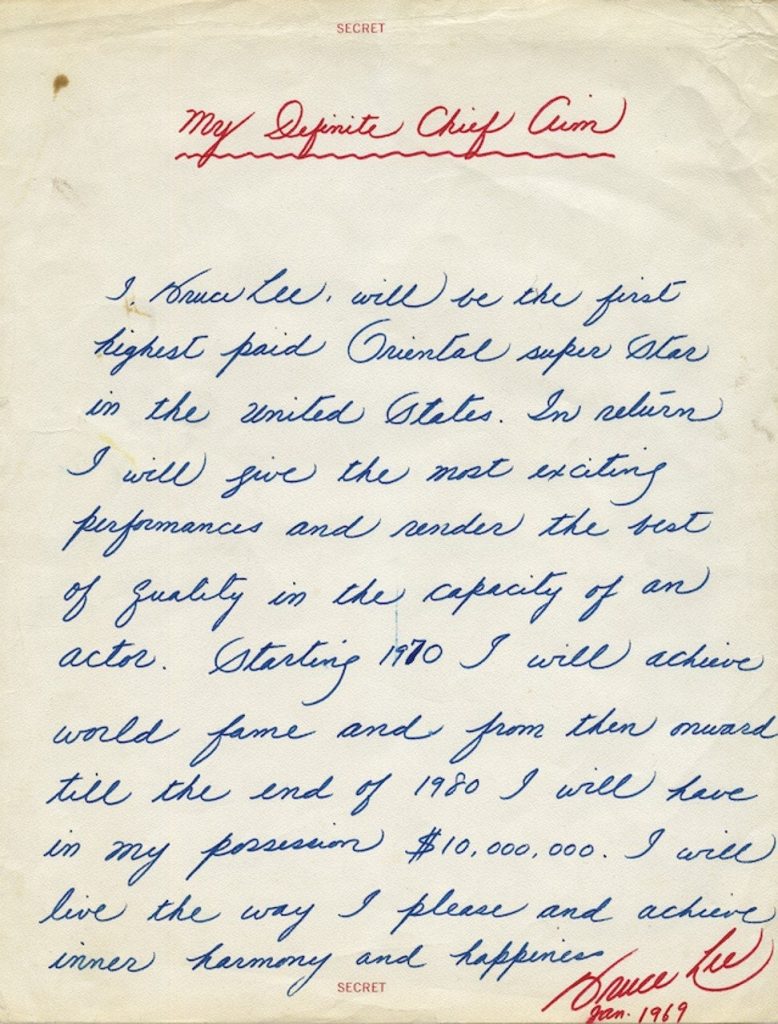
Source: South China Morning Post
Are you squinting to read the flowing text? Well, don’t worry. I’ve got you covered.
Let me decipher and translate it for you.
Here’s what it says:
I, Bruce Lee, will be the first highest paid Oriental super star in the United States. In return I will give the most exciting performances and render the best of quality in the capacity of an actor.
Starting 1970 I will achieve world fame and from then onwards till the end of 1980 I will have in my possession $10,000,000. I will live the way I please and achieve inner harmony and happiness.
Pretty ambitious, isn’t it?
This note was written in January 1969.
Way back when the general public was largely unaware of Bruce Lee.
At the time, he was an actor who had played supporting roles in television shows like The Green Hornet, Ironside, and Longstreet.
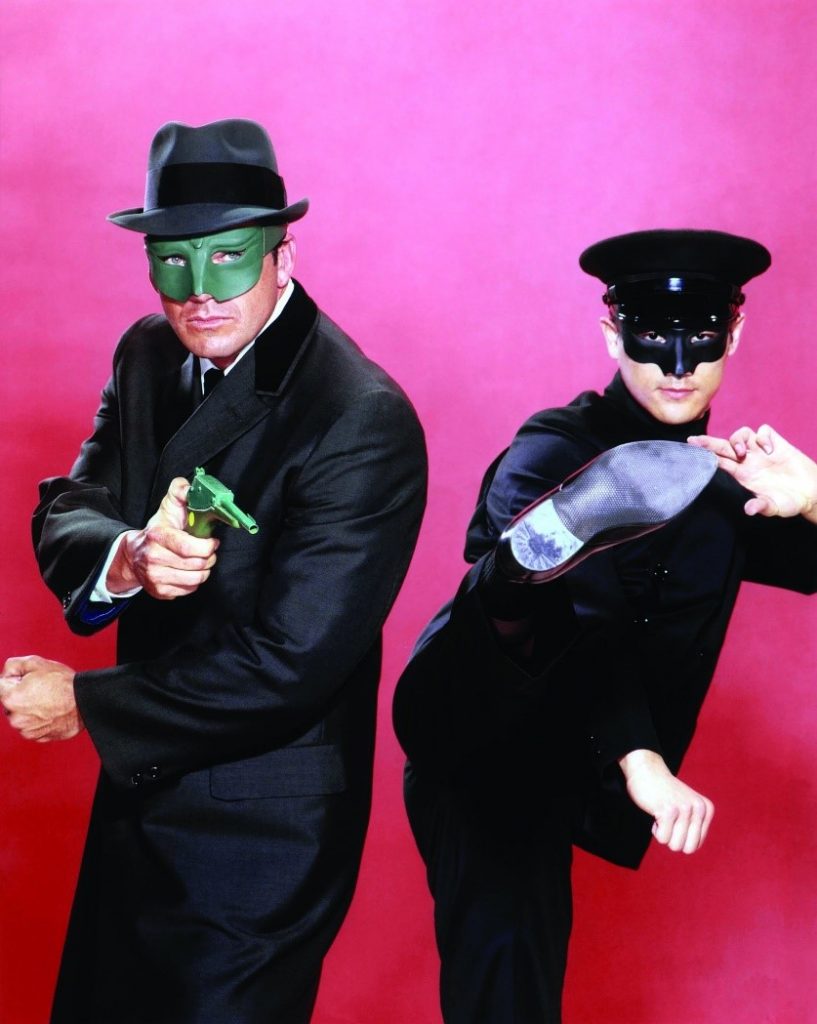
Source: Newsweek
Lee was usually the Asian sidekick to the white lead. Even so, his physical prowess and magnetic presence couldn’t be denied. He moved like a panther, with whiplash energy that was captivating to watch.
There was a reason for this. Even before Lee ventured into acting, he had already established himself as a martial arts instructor. He ran a string of schools across Washington and California.
His rising fame meant that prominent people in Tinseltown sought him out for private lessons.
Lee’s students included:
- Steve McQueen
- James Coburn
- James Garner
- Roman Polanski
- Sharon Tate
Yes, that’s right. Lee had an all-star roster.
So it’s safe to say that he had the connections. Indeed, he dreamed of doing bigger things than just playing supporting roles. His ultimate goal was to headline his own TV show.
Lee was determined and passionate. But the odds were stacked against him. The racial and cultural barriers at the time were enormous. Lee ran into roadblock after roadblock when he met with Hollywood producers.
They didn’t believe that American audiences were ready for an Asian leading man. So they couldn’t commit to Lee. There were simply too many question marks.
Frustrated by the lack of progress, Lee decided to return to Hong Kong. His intention was to build up more credibility before he could take another crack at the American Dream.
An extraordinary background
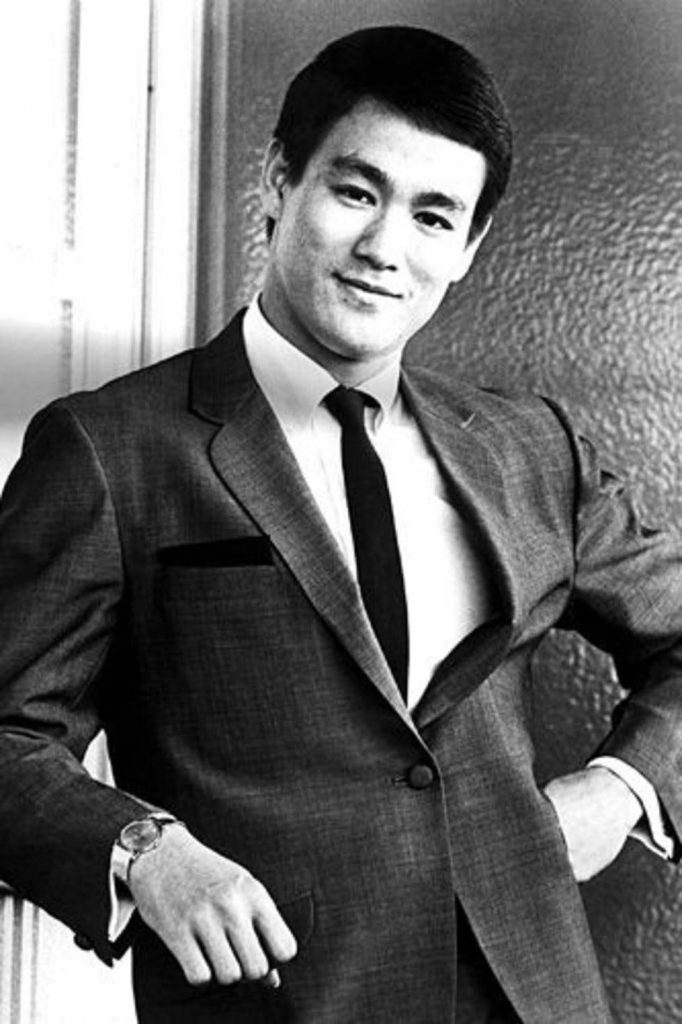
Source: Craftsman Clothing
Here’s the irony: Bruce Lee wasn’t an immigrant at all.
He was actually an American, right from the start.
He was born in 1940 in San Francisco. His parents were performers who toured with the Chinese opera. The family later returned to Hong Kong, where Lee was raised.
Here are some interesting facts:
- When Lee was born, his mother, Grace Ho, actually gave him a unique Chinese name: Lee Jun-fan. Loosely translated, it means ‘return again’. This is significant because Grace strongly felt that her son was destined to ‘return again’ one day to the United States.
- It’s common to think of Lee as being generically Asian. But he was actually multiracial, with a mix of Chinese, European, and Jewish roots.
- His mother, Grace, was half-German. Meanwhile, his great-uncle was Robert Hutong, who was of half-Dutch Jewish descent.
- By most accounts, Lee was an impulsive and headstrong child. He was constantly getting into street fights. Hong Kong in the post-war era was a rowdy city, and soon enough, Lee graduated from bare-knuckle brawling to training in the martial arts.
- In particular, Lee began studying the art of wing chun under famed master Ip Man. However, his Eurasian heritage soon got in the way when Ip Man’s other students exhibited racism and refused to train with him.
- But Lee pushed on and persevered anyway, becoming a star pupil.
- However, the lure of street brawling still proved too irresistible for Lee to ignore. The fights he engaged in became more ferocious. At one point, he even injured a student from a rival martial arts school, which got the police involved.
- Eventually, Lee’s parents decided that enough was enough. They would send him to California to live with his older sister, Agnes. They hoped that the change of culture and scenery would do him good.
Of course, the timing was perfect. Lee was American-born, and now that he was 18, it seemed like a good time to claim that citizenship.
Also, this move seemed to be the fulfilment of his mother’s prophecy. To ‘return again’ to the United States. To try and capture the American Dream.
And so, in 1959, Lee landed in San Francisco, before relocating to Seattle. He attended high school, then went to college at the University of Washington, studying drama, philosophy, and psychology.
It was in Seattle that he met Linda Emery — American-born, of Swedish, Irish, and English descent. They began a relationship that transcended cultural barriers, fuelled by their shared love of martial arts.
Unfortunately, anti-miscegenation laws were still being enforced at the time. This meant that relations between white and coloured people were forbidden. So the young couple had no choice but to marry in secret in 1964.
Nonetheless, Linda would become Lee’s most ardent supporter — encouraging him on his journey to set up martial arts schools that would offer a curriculum that blended East and West.
Lee also made tentative steps into Hollywood, dreaming of hitting it big one day.
Achieving stardom
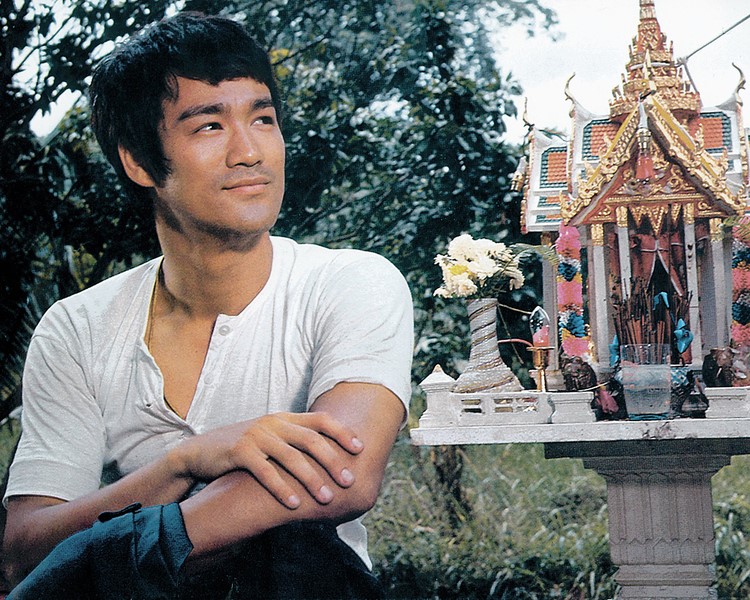
Source: Official Bruce Lee Page
A meteoric rise.
That’s what happened when Bruce Lee returned to Hong Kong.
In the space of just under two years — from 1971 to 1972 — Bruce Lee appeared in three local productions:
- The Big Boss
- Fist of Fury
- Way of the Dragon
These movies served as the perfect showcase for Lee’s kinetic fighting style, which audiences had never seen on the big screen before.
Here’s what Lee included:
- The classical stances of European fencing
- The nimble footwork of American boxing
- The flowing combat of Chinese kung fu
Lee called his philosophy jeet kune do — the way of the intercepting fist.
He explained:
‘Be formless, shapeless, like water. You put water into a cup, it becomes the cup. You put water into a bottle, it becomes the bottle. You put it into a teapot, it becomes the teapot. Now water can flow or it can crash. Be water, my friend.’
With this, Lee quickly exploded into stardom in Asia. Hollywood finally took notice of him, bankrolling an international production — Enter the Dragon.
At last, Lee would have what he always wanted: a leading Hollywood role in a James Bond-style thriller.
Indeed, Lee seemed poised to go from regional superstar to international superstar.
Then…tragedy struck.
Three weeks before Enter the Dragon premiered in the United States in 1973, Lee fell into a sudden coma and died. His brain had swelled due to an adverse reaction to medication he had been taking at the time.
By most accounts, Lee had simply pushed himself too hard, physically and mentally. His drive to succeed had taken a terrible toll. He was only 32 when he passed.
Enter the Dragon went on to gross over US$350 million at the box office — which is over $1 billion today, adjusted for inflation.
It’s a truly remarkable feat.
An achievement that Lee himself did not live to see.
Enduring legacy
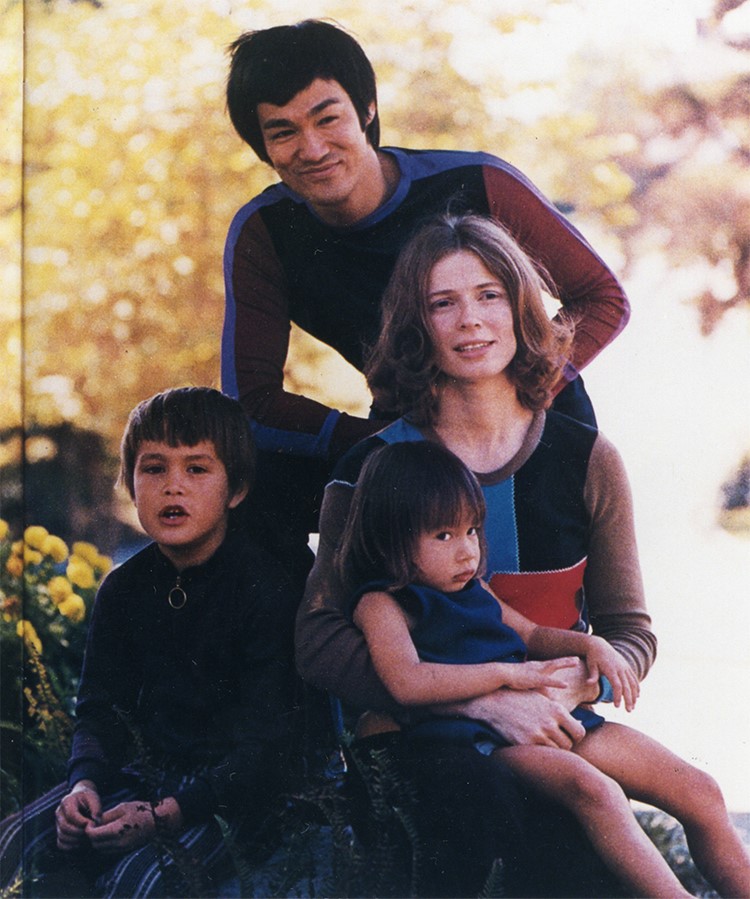
Source: Official Bruce Lee Page
There’s no denying it: Lee accomplished more in his 32 years than most people do in a lifetime.
His biggest triumph, perhaps, was closing the gap between East and West. Promoting cross-cultural understanding. Shattering glass ceilings.
Dana White, president of Ultimate Fighting Championship (UFC), has credited Lee as being the father of mixed martial arts (MMA):
‘You’ve got to cross-train in many different systems … If you look at the way Bruce Lee trained, the way he fought, and many of the things he wrote, he said the perfect style was no style. You take a little something from everything. You take the good things from every different discipline, use what works, and you throw the rest away.’
Irish MMA fighter Connor McGregor praises Lee’s athletic ability:
‘I have no doubt he would have been world champion in MMA, no doubt,’ McGregor said ahead of UFC Fight Night 37 in 2014. ‘He’s fluid, he’s loose, he’s fast. His movement is fluid, it’s efficient, it’s functional.’
American boxing legend Sugar Ray Leonard pays tribute to Lee’s philosophy:
‘Bruce Lee was one of my idols, mainly because of his mental stability, because of his fighting spirit, because it was more mental than just physical. For him, it was like what he called emotional content.
‘It all ties in together that you must — your mind, your body, your spirit — must all connect to get the best results. Bruce was an example of what materialized from hard work and there were no boundaries. There was no racial barriers, there was nothing.’
Now, given the scale of Lee’s achievements, conspiracy theories are sure to abound. Was his death suspicious? Was he murdered because he was too much of an advocate of breaking down barriers? Was the criminal underworld somehow involved in foul play?
Linda, Lee’s widow, has dismissed such speculation. In her poignant words:
‘All these years later, people still wonder about how Bruce died. I prefer to remember how he lived.’
Lessons for investors
During his lifetime, Bruce Lee rejected the narrow orthodoxy of traditional martial arts. He didn’t want to limit himself to just striking or trapping or grappling. Instead, he embraced a holistic philosophy where all techniques were relevant and necessary.
So, as an investor, here are the critical lessons you need to consider as you map out your own blueprint for success:
- Be observant
- Be adaptable
- Be international
At the moment, are you investing only in one market? In one industry? Using just one approach? Well, if you are, maybe it’s time to diversify.
In our Quantum Wealth Report, we are currently exploring global opportunities in property, infrastructure, energy, technology, and so much more.
It’s about giving you the best financial intelligence — so you can find the inspiration to be robust and well-rounded.
Just like Bruce Lee’s philosophy of jeet kune do.
Be water, my friend.
Regards,
John Ling
Analyst, Wealth Morning





John is the Chief Investment Officer at Wealth Morning. His responsibilities include trading, client service, and compliance. He is an experienced investor and portfolio manager, trading both on his own account and assisting with high net-worth clients. In addition to contributing financial and geopolitical articles to this site, John is a bestselling author in his own right. His international thrillers have appeared on the USA Today and Amazon bestseller lists.